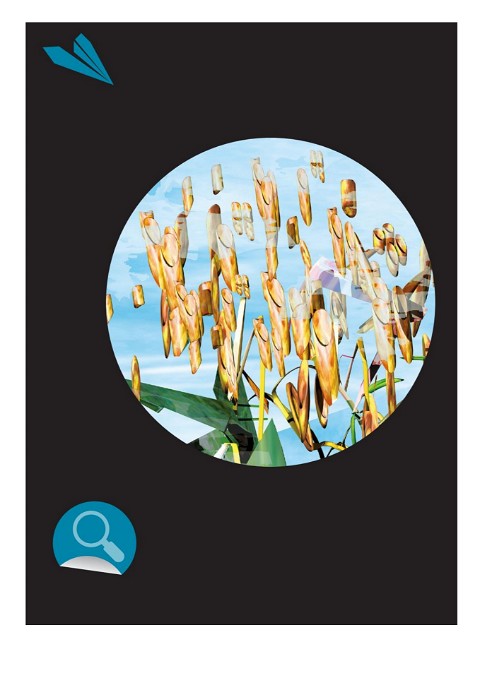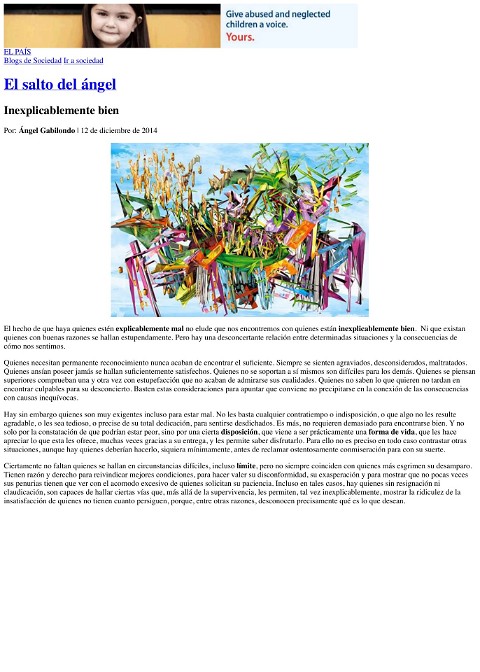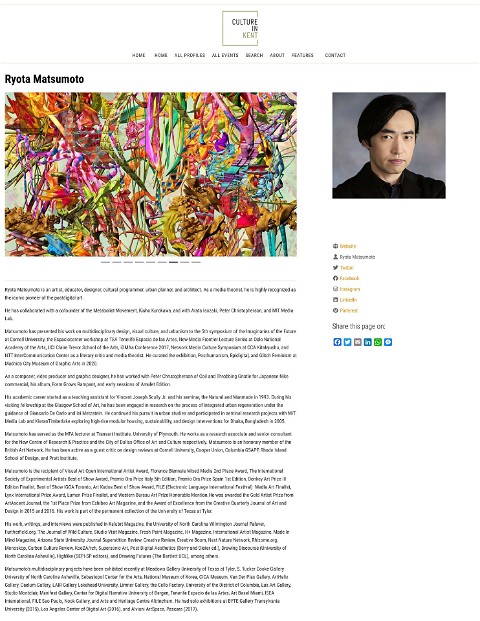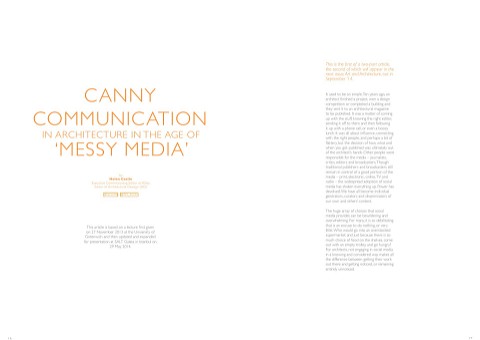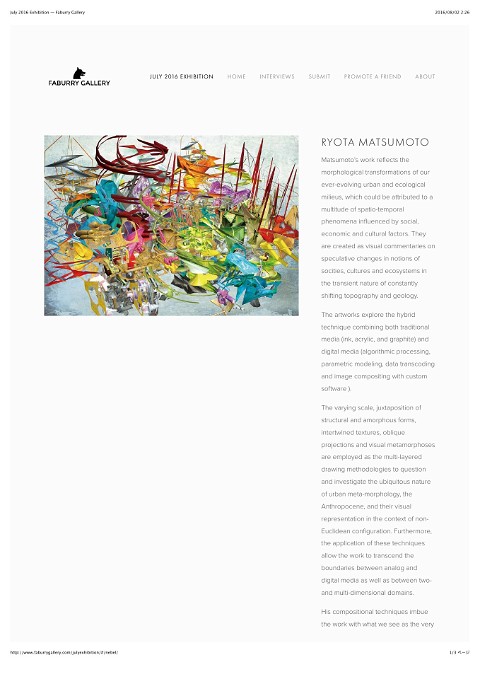Interview with Ryota Matsumoto | ARTiculAction Art Review - March20 2015
>100 Views
October 25, 23
スライド概要
Ryota Matsumoto (松本良多) is an artist, educator, designer, cultural programmer, urban planner, and architect. As a media theorist, he is highly recognized as the iconic pioneer of the postdigital culture.
He has collaborated with a cofounder of the Metabolist Movement, Kisho Kurokawa, and with Arata Isozaki, Peter Christopherson, and MIT Media Lab.
Matsumoto has presented his work on multidisciplinary design, visual culture, and urbanism to the 5th symposium of the Imaginaries of the Future at Cornell University, the Espaciocenter workshop at TEA Tenerife Espacio de las Artes, New Media Frontier Lecture Series at Oslo National Academy of the Arts, UCI Claire Trevor School of the Arts, iDMAa Conference 2017, Network Media Culture Symposium at CCA Kitakyushu, and NTT InterCommunication Center as a literary critic and media theorist. He curated the exhibition, Posthumanism, Epidigital, and Glitch Feminism at Machida City Museum of Graphic Arts in 2020.
As a composer, video producer and graphic designer, he has worked with Peter Christopherson of Coil and Throbbing Gristle for Japanese Nike commercial, his album, Form Grows Rampant, and early sessions of Amulet Edition.
His academic career started as a teaching assistant for Vincent Joseph Scully Jr. and his seminar, the Natural and Manmade in 1993. During his visiting fellowship at the Glasgow School of Art, he has been engaged in research on the process of integrated urban regeneration under the guidance of Giancarlo De Carlo and Isi Metzstein. He continued his pursuit in urban studies and participated in seminal research projects with MIT Media Lab and KieranTimberlake exploring high-rise modular housing, sustainability, and design interventions for Dhaka, Bangladesh in 2005.
Matsumoto has served as the MFA lecturer at Transart Institute, University of Plymouth. He works as a research associate and senior consultant for the New Centre of Research & Practice and the City of Dallas Office of Art and Culture respectively. Matsumoto is an honorary member of the British Art Network. He has been active as a guest critic on design reviews at Cornell University, Cooper Union, Columbia GSAPP, Rhode Island School of Design, and Pratt Institute.
Matsumoto is the recipient of Visual Art Open International Artist Award, Florence Biennale Mixed Media 2nd Place Award, The International Society of Experimental Artists Best of Show Award, Premio Ora Prize Italy 5th Edition, Premio Ora Prize Spain 1st Edition, Donkey Art Prize III Edition Finalist, Best of Show IGOA Toronto, Art Kudos Best of Show Award, FILE (Electronic Language International Festival) Media Art Finalist, Lynx International Prize Award, Lumen Prize Finalist, and Western Bureau Art Prize Honorable Mention.He was awarded the Gold Artist Prize from ArtAscent Journal, the 1st Place Prize from Exhibeo Art Magazine, and the Award of Excellence from the Creative Quarterly Journal of Art and Design in 2015 and 2016. His work is part of the permanent collection of the University of Texas at Tyler.
His work, writings, and interviews were published in Kalubrt Magazine, the University of North Carolina Wilmington Journal Palaver, Furtherfield.org, The Journal of Wild Culture, Studio Visit Magazine, Fresh Paint Magazine, H+ Magazine, International Artist Magazine, Made In Mind Magazine, Arizona State University Journal Superstition Review, Creative Review, Creative Boom, Next Nature Network, Rhizome.org, Monoskop, Carbon Culture Review, KooZA/rch, Supersonic Art, Post Digital Aesthetics (Berry and Dieter ed.), Drawing Discourse (University of North Carolina Asheville), Highlike (SEPI-SP editors), and Drawing Futures (The Bartlett UCL), among others.
Matsumoto’s multidisciplinary projects have been exhibited recently at Meadows Gallery University of Texas at Tyler, S. Tucker Cooke Gallery University of North Carolina Asheville, Sebastopol Center for the Arts, National Museum of Korea, CICA Museum, Van Der Plas Gallery, ArtHelix Gallery, Caelum Gallery, LAIR Gallery Lakehead University, Limner Gallery, the Cello Factory, University of the District of Columbia, Lux Art Gallery, Studio Montclair, Manifest Gallery, Center for Digital Narrative University of Bergen, Tenerife Espacio de las Artes, Art Basel Miami, ISEA International, FILE Sao Paulo, Nook Gallery, and Arts and Heritage Centre Altrincham. He had solo exhibitions at BYTE Gallery Transylvania University (2015), Los Angeles Center of Digital Art (2016), and Alviani ArtSpace, Pescara (2017).
関連スライド
各ページのテキスト
ARTiculAction Ryota Matsumoto (Japan) An artist's statement The artworks of Ryota Matsumoto develop and demonstrate the hybrid/multi-layered process, where varying scale, juxtaposition of different forms, intertwined textures/tones are applied to reflect the spatio-temporal conditions of our ever-evolving urban and ecological environments. They are created to act as the catalyst for defining speculative changes in our notions of cities, socities and cultures. His drawings explore a hybrid drawing technique combining both traditional media (ink, acrylic, and graphite) and digital media (algorithmic processing, scripting and image compositing with custom software ). The algorithmic and generative processes are applied to create lines, curves and multi-dimensional forms. Then they are redefined and reconfigured with traditional painting/drawing techniques that add colors, textures and details to compositions. Ryota Matsumoto is a principal of an award-winning design office, Ryota Matsumoto Studio based in Tokyo. He is an artist, designer and urban planner. Born in 1972, Ryota was raised in Hong Kong and Japan. He received Master of Architecture from University of Pennsylvania in 2007 after studying at Architectural Association in London and Mackintosh School of Architecture, Glasgow School of Art in early 90’s. His art and built work are featured in numerous publications and exhibitions internationally. His current interest gravitates around the embodiment of cultural possibilities in art, architecture, and urban topography. Ryota Matsumoto Marked by the Atlas of an Endless Spin Cy
cle, Medium: Mixed Media, Year: 2014, Dimensions: 33inx45in ARTiculAction
ARTiculAction An interview with Ryota Matsumoto An interview by Dario Rutigliano, curator Ryota Matsumoto is not just an interesting artist, but also an accomplished designer and urban planner: the deep symbiosis between elements from Architecture, Design and Technology allows the viewer to perceive the subtle but undeniable continuity between tradition and modernity. Through a refined approach in which techniques from opposite disciplines as graphite drawing and algorithmic processing, merge together in an harmonious combination, he gives life to a multi-layered experience and effectively stresses the way in which our perception of abstract shapes depends on cultural perspectives It is with a real pleasure that I would like to introduce our readers to his stimulating works. Hello Ryota, and welcome to ARTiculAction. I would start this interview with my usual introductory question: what in your opinion defines a work of Art? By the way, what could be in your opinion the features that mark an artworks as a piece of Contemporary Art? Hello, Thank you for giving the opportunity to talk about my work. I always perceive art as a means to mirror and reflect socio-economic and cultural substrates in the past, present and possibly future from one’s unique point of view. I believe the most successful art transmits ideas and values inherent in our culture across the wide span of space and time. That is why great works of art manage to stay relevant for a long time to come. In the ideal world, we could examine the past, interpret the present and even conjecture about the future strictly within the framework of single piece of art. Ryota Matsumoto To a large extent, Contemporary Art could be defined as fine art that manages to explore timeless themes with the use of current technologies or drawing techniques. Of course, there are also impending issues of multiculturalism, globalization and ecological concerns that we might need to address with particular emphasis in order to meet the criteria of Contemporary Art, but I always consider a guiding principle that defines art, remains the same for centuries and Contemporary Art is no exception for sure. Would you like to tell us something about your background? You have a very solid education, and after your studies at Architectural Association in London and Mackintosh School of Architecture, Glasgow, you degreed with a Master of Architecture from University of Pennsylvania. How have these experiences impacted on your developement as an artist
Ryota Matsumoto ARTiculAction the High Overdrive and Its Undefinable Consequence Mixed Media 141221 79cmx119cm and on the way you currently produce your artworks? I believe all the schools help me establish my own perspective and identity for working in the creative field one way or the other. I’d also like to point out that every school has their own unique direction and strength in pedagogical approach that is attributed to their culturally diverse student body and specific geographical location of the school. These school characteristics allow me to learn and explore the various facets of creativity and innovation in Architecture and Art. At any rate, the most important lesson that I learned from my education comes down to always being open minded to new and different ideas. It definitely supports my broad outlook on life as well. Before starting to elaborate about your production, would you like to tell to our readers something about your process and set up for making your artworks? In particular, what technical aspects do you mainly focus on your work? And how much preparation and time do you put in before and during the process of creating a piece? I use several different mediums and always avoid being overtly systematic. So I take on a different approach for every work. As far as
ARTiculAction common factors among my work are concerned, I always employ a hybrid technique that blends traditional techniques with digital media. That is actually the most crucial aspect of my work. The hybrid technique allows me to add a warm human touch and layers of texture to a precision of digital drawings. I usually need a few days for preparation. However, I take an improvisational approach to my painting occasionally. In that case, I am less preoccupied with technical and compositional issues. Now let's focus on your artistic production: I would start from "Hollow Ghosts for Those Restless Spirits" that our readers have already started to get to know in the introductory pages of this article: and I would suggest to our readers to visit yur website directly at http://ryotamatsumotostudio.blog spot.it/ in order to get a wider idea of your artistic production... In the meanwhile, would you like to tell us something about the genesis of these works? What was your initial inspiration? I believe one of the most important aspects of creating art is intuition and the other aspect is one’s personal experience and individual background. In my case, my over twenty years experience in architecture and urban design play the pivotal role in my creative process and inspiration. With this work, I am inspired by the relationship of people to architecture in modern urban settings and also captured the snapshot of the rapid changes of cityscapes with the depiction of Ryota Matsumoto
Ryota Matsumoto ARTiculAction
ARTiculAction Ryota Matsumoto the Intersection of Infinite Planes, Medium: Mixed Media, Year: 2014, Dimensions: 27inx47in various forms in the assembly/disassembly procedures. One of the features of the Intersection of Infinite Planes that has impacted on me is the way you effectively challenge the dichotomy between the perception of the real and the oniric dimension...so I would like to ask you if in your opinion personal experience is an absolutely indespensable part of a creative process... Do you think that
Ryota Matsumoto the Indistinct Notion of an Object Trajectory Mixed Media 141210 75cmx56cm dichotomy and contrapuntal relationship among organic and inorganic, structural and amorphous as well as small/personal objects and large structures. These polar opposite elements could integrate with each other and morph into totally new structures in my paintings. My direct experience can be defined as a springboard for triggering initial inspiration. Then my imagination takes it further beyond my experience. a creative process could be disconnected from direct experience? I’ve often worked with contemporary ethical and aesthetic values of cities and their rapid developments which can be characterized by Multidisciplinarity is a crucial aspect of your art practice and maybe because I have a scientific background, I'm always delighted to come across an interesting example of how Art and Technology can establish an effective symbiosis, as in the interesting "Those Who
ARTiculAction Ryota Matsumoto Those Who Affirm the Spontaneity of Every Event Mixed Media 140821 84cmx119cm Affirm the Spontaneity of Every Event", where you have created a rich combination between traditional materials as ink, acrylic, graphite and digital media so I would take this occasions to ask what's your point about this fruitful contamination... By the way, while crossing the borders of different artistic fields have you ever happened to realize that a symbiosis between different disciplines is the only way to achieve some results, to express some concepts? The hybrid technique comes naturally to me since I’ve worked as a designer and an artist for quite a while. The confluence of seemingly opposing techniques are aimed at achieving both earthiness/warmness of traditional painting and delicate complexity of digital art in my work. I think we can no longer rely on onedimensional/ traditional representational systems to decipher and depict the intricacies of our contemporary society and the humanization of digital technologies are certainly indispensable for venturing into the new paradigm of fine art.
Ryota Matsumoto ARTiculAction the Hanging Gardens of Ancient Creek, Mixed Media 141207 84cmx119cm Another interesting pieces of yours on which I would like to spend some words are entitled "the Hanging Gardens of Ancient Creek" and "Stretched into an Infinite Vapor of Spectral Resonance": one of the feature that has mostly struck on me is the dynamicity, the sense of movement that you have been capable of impressing on the canvas... and I have highly appreciated the nuance of intense red which, combining with vivid tones, creates an interesting synergy rather than a contrast, and especially on the neutral background: by the way, any comments on your choice of "palette" and how it has changed over time? I have tendency to use the color of stark contrast to create the sense of movement and dynamism to the overall composition. That being said, the subtle difference in color is also applied to express a sense of depth and to give the clarity to figure-ground relationship. I have highly appreciates the way your multilayered approach is capable of bringing an high level of significance to abstract shapes:
ARTiculAction Ryota Matsumoto
Ryota Matsumoto ARTiculAction
ARTiculAction Ryota Matsumoto
Ryota Matsumoto ARTiculAction and I would go as far as to state that in a certain sense your works urge the viewers' perception in order to challenge the common way to perceive not only the outside world, but our inner dimension... By the way, I'm sort of convinced that some informations & ideas are hidden, or even "encrypted" in the environment we live in, so we need -in a way- to decipher them. Maybe that one of the roles of an artist could be to reveal unexpected sides of Nature, especially of our inner Nature... what's your point about this? My artworks embrace and transmit everdiversifing interdisciplinary views on the urban milieu in which we live in today. At the same time, there are also more personal works which are generated from their own narrative structures to stand on their own as individual entities. So I’d say most of my work are often layered with multiple meanings and are also very much open to anyone’s interpretation simultaneously. As you have stated once, your current interest gravitates around the embodiment of cultural possibilities in art, architecture, and urban topography: I can recognize in this a socio politic feature and although I'm aware that this might sound a bit naïf, I have to admit that I'm sort of convinced that Art -especially nowadays- could play an effective role in sociopolitical questions, as in human rights issues: not only just by offering to people a generic platform for expression... I would go as far as to state that Art could even steer people's behaviour... what's your point about this? Does it sound a bit exaggerated? I am much more interested in the psychological effects of art and how it changes and affects one’s aesthetic experience. To a large extent, this also involves how people relate themselves to art in the context of their everyday lives. I wouldn’t go so far as to say art is able to steer one’s view towards sociopolitical agendas.
Space Station Talks Visualized From Orbiter Mixed Media 150111 71cmx118cm
ARTiculAction Ryota Matsumoto You are an accomplished artist and a principal of an award-winning design office: during your career your works have been shown in several occasions: it goes without saying that feedbacks and especially awards are capable of supporting an artist: I was just wondering if the expectation of a positive feedbackcould even influence the process of an artist... do you take the audience into account when you are planning or creating a piece? It is almost impossible to please everyone with my art. Hopefully, it appeals to a certain people and that is something I might take into consideration, while working on a piece. Thanks a lot for your time and for sharing your thoughts, Ryota. My last question deals with your future plans: what's next for you? Anything coming up for you professionally that you would like readers to be aware of? It is always my pleasure! I’ve been working on a collaborative project with both industrial designer and architect for a while. There will also be exhibitions of my work in Italy and the United States this year. Our Perceptions Lay Bare as Incongruent Swashes Pass Overhead Mixed Media 150226 77cmx119cm
Ryota Matsumoto ARTiculAction
